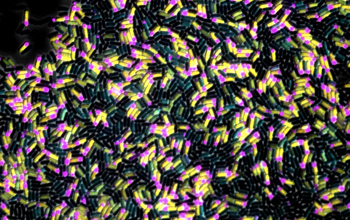Multimedia Gallery
Bacteria delay survival decisions
Bacillus subtilis is a common soil bacterium that forms a spore when food runs short. New research by scientists at Rice University and the University of Houston has found that B. subtilis begins preparing for survival in hard times, even as it delays the ultimate decision of whether to form a spore. Researchers used fluorescent labels to measure the production of spore-forming genes. This image shows a heterogeneous population of starving bacterial cells that includes both non-sporulating cells (dark blue) and cells that have begun spore-formation by dividing asymmetrically into large (yellow) and small (pink).
Although B. subtilis is harmless to humans, there are some dangerous bacteria like anthrax that also form spores. Scientists are anxious to better understand the process, both to protect public health and to explore the evolution of complex genetic processes.
This research was supported in part by a grant from the National Science Foundation: Project Title: Systems Analysis of the Sporulation Initiation Network in the Bacterium Bacillus subtilis (MCB-0920463).
To learn more, see the Rice University news story Deciphering bacterial doomsday decisions--Rice University-led study finds bacteria delay survival decisions. (Date of Image: July 2012)
Credit: Masaya Fujita, University of Houston
See other images like this on your iPhone or iPad download NSF Science Zone on the Apple App Store.
Images and other media in the National Science Foundation Multimedia Gallery are available for use in print and electronic material by NSF employees, members of the media, university staff, teachers and the general public. All media in the gallery are intended for personal, educational and nonprofit/non-commercial use only.
Images credited to the National Science Foundation, a federal agency, are in the public domain. The images were created by employees of the United States Government as part of their official duties or prepared by contractors as "works for hire" for NSF. You may freely use NSF-credited images and, at your discretion, credit NSF with a "Courtesy: National Science Foundation" notation.
Additional information about general usage can be found in Conditions.
Also Available:
Download the high-resolution JPG version of the image. (3.9 MB)
Use your mouse to right-click (Mac users may need to Ctrl-click) the link above and choose the option that will save the file or target to your computer.

